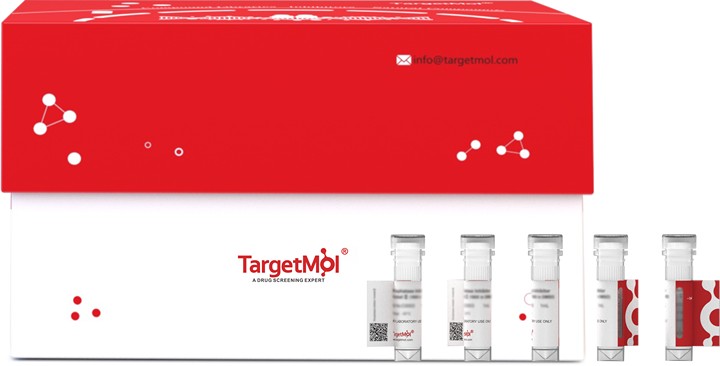购物车
全部删除  您的购物车当前为空
您的购物车当前为空
TIM-3/KIM-3/HAVCR2 Protein, Human, Recombinant (hFc) is expressed in HEK293 Cells. The accession number is Q8TDQ0.

| 规格 | 价格 | 库存 | 数量 |
|---|---|---|---|
| 5 μg | ¥ 719 | 6-8日内发货 | |
| 10 μg | ¥ 1,190 | 6-8日内发货 | |
| 20 μg | ¥ 1,980 | 5日内发货 | |
| 50 μg | ¥ 3,960 | 5日内发货 | |
| 100 μg | ¥ 5,850 | 5日内发货 | |
| 200 μg | ¥ 8,660 | 5日内发货 | |
| 500 μg | ¥ 14,500 | 5日内发货 | |
| 1 mg | ¥ 21,600 | 5日内发货 |
| 生物活性 | Assay #1: Immobilized TIM-3, hFc, Human at 0.5 μg/ml, the concentration of Anti-TIM3 mouse antibody (Genscript) that produces 50% optimal binding response is found to be approximately 5.0 ng/ml. Assay #2: Immobilized Galectin-9, His, Human at 0.5 μg/ml (100 µl/well) can bind TIM-3, hFc, Human with a linear range of 0.78-6.25 μg/ml. |
| 产品描述 | TIM-3/KIM-3/HAVCR2 Protein, Human, Recombinant (hFc) is expressed in HEK293 Cells. The accession number is Q8TDQ0. |
| 种属 | Human |
| 表达系统 | HEK293 Cells |
| 标签 | hFc |
| 蛋白编号 | Q8TDQ0 |
| 别名 | TIMD-3,TIM-3,T-cell membrane protein 3,T-cell immunoglobulin mucin receptor 3,T-cell immunoglobulin and mucin domain-containing protein 3,Hepatitis A virus cellular receptor 2,HAVcr-2 |
| 蛋白构建 | Ser22-Arg200 |
| 蛋白纯度 | > 95% as determined by SDS-PAGE |
| 分子量 | 60~65 kDa (Reducing conditions) |
| 内毒素 | < 0.2 EU/μg of protein as determined by the LAL method. |
| 缓冲液 | Lyophilized from a 0.2 μm filtered solution in PBS. |
| 复溶方法 | Reconstitute the lyophilized protein in sterile deionized water. The product concentration should not be less than 100 μg/ml. Before opening, centrifuge the tube to collect powder at the bottom. After adding the reconstitution buffer, avoid vortexing or pipetting for mixing. |
| 存储 | Upon receiving, this product remains stable for up to 6 months at lower than -70°C. Upon reconstitution, the product should be stable for up to 1 week at 4°C or up to 3 months at -20°C. For long term storage it is recommended that a carrier protein (example 0.1% BSA) be added. Avoid repeated freeze-thaw cycles. |
| 运输方式 | In general, Lyophilized powders are shipping with blue ice. Solutions are shipping with dry ice. |
| 研究背景 | T cell Ig- and mucin-domain-containing molecules (TIMs) are a family of transmembrane proteins expressed by various immune cells. TIM-3 is an inhibitory molecule that is induced following T cell activation. TIM-3 is expressed by exhausted T cells in the settings of chronic infection and cancer, and tumor-infiltrating T cells that co-express PD-1 and TIM-3 exhibit the most severe exhausted phenotype. Tumor-infiltrating dendritic cells also express TIM-3. TIM-3 expression on DCs was found to suppress innate immunity by reducing the immunogenicity of nucleic acids released by dying tumor cells. Research studies show that heterodimerization of TIM-3 with CEACAM-1 is critical for the inhibitory function of TIM-3, and co-blockade of TIM-3 and CEACAM-1 enhanced antitumor responses in a mouse model of colorectal cancer. Its binding to Galectin-9 induces a range of immunosuppressive functions which enhance immune tolerance and inhibit anti-tumor immunity. TIM-3 ligation attenuates CD8 + and Th1 cell responses and promotes the activity of Treg and myeloid derived suppressor cells. In addition, dendritic cell-expressed TIM-3 dampens inflammation by enabling the phagocytosis of apoptotic cells and the cross-presentation of apoptotic cell antigens. |